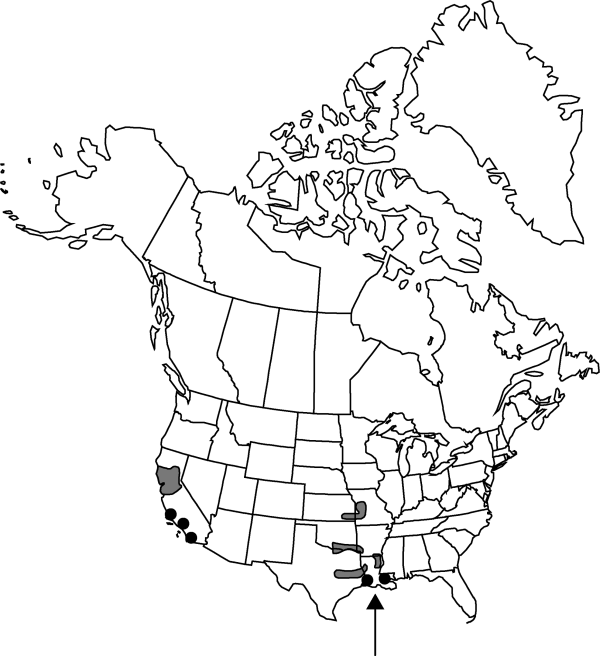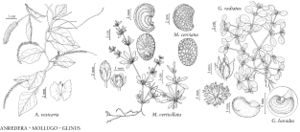Difference between revisions of "Glinus lotoides"
Sp. Pl. 1: 463. 1753.
FNA>Volume Importer |
imported>Volume Importer |
||
| (7 intermediate revisions by 2 users not shown) | |||
| Line 8: | Line 8: | ||
}} | }} | ||
|common_names=Damascisa | |common_names=Damascisa | ||
| + | |special_status={{Treatment/ID/Special_status | ||
| + | |code=I | ||
| + | |label=Introduced | ||
| + | }}{{Treatment/ID/Special_status | ||
| + | |code=F | ||
| + | |label=Illustrated | ||
| + | }} | ||
|basionyms= | |basionyms= | ||
|synonyms={{Treatment/ID/Synonym | |synonyms={{Treatment/ID/Synonym | ||
|name=Glinus dictamnoides | |name=Glinus dictamnoides | ||
|authority=Burman f. | |authority=Burman f. | ||
| − | }}{{Treatment/ID/Synonym | + | |rank=species |
| + | }} {{Treatment/ID/Synonym | ||
|name=Mollugo glinus | |name=Mollugo glinus | ||
|authority=A. Richard | |authority=A. Richard | ||
| − | }}{{Treatment/ID/Synonym | + | |rank=species |
| + | }} {{Treatment/ID/Synonym | ||
|name=Mollugo hirta | |name=Mollugo hirta | ||
|authority=Thunberg | |authority=Thunberg | ||
| + | |rank=species | ||
}} | }} | ||
|hierarchy=Molluginaceae;Glinus;Glinus lotoides | |hierarchy=Molluginaceae;Glinus;Glinus lotoides | ||
| Line 26: | Line 36: | ||
}}<!-- | }}<!-- | ||
| − | --><span class="statement" id="st- | + | --><span class="statement" id="st-undefined" data-properties=""><b>Stems </b>0.5–3.5 dm. <b>Leaves</b> whorled; petiole 1–7 mm; blade obovate or orbiculate to broadly spatulate, 5–25 × 0.4–17 mm, base cuneate, apex broadly rounded to acute. <b>Flowers</b> in clusters of 3–15; sepals lanceolate, 3.5–4.1 × 0.4–2 mm, stellate-pubescent abaxially, glabrous adaxially, apex rounded to acute or slightly mucronate; stamens 3–5. <b>Capsules</b> ellipsoid, 3.6–4.5 × 1.8–2 mm. <b>Seeds</b> 10–25 per locule, orange-brown, 0.4–0.6 × 0.3–0.4 mm, papillate, somewhat glossy or dull; papillae sometimes black. <b>2n</b> = 36.</span><!-- |
-->{{Treatment/Body | -->{{Treatment/Body | ||
| + | |phenology=Flowering late summer–fall. | ||
|habitat=Moist soils, river bottoms, lake margins, marshes, waste places | |habitat=Moist soils, river bottoms, lake margins, marshes, waste places | ||
|elevation=0-1300 m | |elevation=0-1300 m | ||
|distribution=Ark.;Calif.;Kans.;La.;Mo.;Okla.;Tex.;Mexico;West Indies;South America;Eurasia;Africa;Australia. | |distribution=Ark.;Calif.;Kans.;La.;Mo.;Okla.;Tex.;Mexico;West Indies;South America;Eurasia;Africa;Australia. | ||
| − | |discussion=<p>Glinus lotoides is native to Eurasia and Africa and has become widespread in tropical, subtropical, and warm-temperate areas worldwide. Several varieties have been described, but their delimitations are unclear and need further investigation. The vernacular name “damascisa” is applied to this species, as well as several other plants, which are used in Africa for treatment of diabetes and skin ailments (A. El-Hamidi et al. 1967). In India, the species is used as treatment for diarrhea, boils, and abdominal diseases, as well as weakness in children (K. R. Kirtikar and B. D. Basu 1935). Antihelmintic properties are reported for G. lotoides from several African studies (B. Abegaz and B. Tecle 1980; G. Broberg 1980).</p> | + | |introduced=true |
| + | |discussion=<p><i>Glinus lotoides</i> is native to Eurasia and Africa and has become widespread in tropical, subtropical, and warm-temperate areas worldwide. Several varieties have been described, but their delimitations are unclear and need further investigation. The vernacular name “damascisa” is applied to this species, as well as several other plants, which are used in Africa for treatment of diabetes and skin ailments (A. El-Hamidi et al. 1967). In India, the species is used as treatment for diarrhea, boils, and abdominal diseases, as well as weakness in children (K. R. Kirtikar and B. D. Basu 1935). Antihelmintic properties are reported for <i>G. lotoides</i> from several African studies (B. Abegaz and B. Tecle 1980; G. Broberg 1980).</p> | ||
|tables= | |tables= | ||
|references= | |references= | ||
| Line 41: | Line 53: | ||
-->{{#Taxon: | -->{{#Taxon: | ||
name=Glinus lotoides | name=Glinus lotoides | ||
| − | |||
|authority=Linnaeus | |authority=Linnaeus | ||
|rank=species | |rank=species | ||
| Line 48: | Line 59: | ||
|basionyms= | |basionyms= | ||
|family=Molluginaceae | |family=Molluginaceae | ||
| + | |phenology=Flowering late summer–fall. | ||
|habitat=Moist soils, river bottoms, lake margins, marshes, waste places | |habitat=Moist soils, river bottoms, lake margins, marshes, waste places | ||
|elevation=0-1300 m | |elevation=0-1300 m | ||
|distribution=Ark.;Calif.;Kans.;La.;Mo.;Okla.;Tex.;Mexico;West Indies;South America;Eurasia;Africa;Australia. | |distribution=Ark.;Calif.;Kans.;La.;Mo.;Okla.;Tex.;Mexico;West Indies;South America;Eurasia;Africa;Australia. | ||
| + | |introduced=true | ||
|reference=None | |reference=None | ||
|publication title=Sp. Pl. | |publication title=Sp. Pl. | ||
|publication year=1753 | |publication year=1753 | ||
| − | |special status= | + | |special status=Introduced;Illustrated |
| − | |source xml=https:// | + | |source xml=https://bitbucket.org/aafc-mbb/fna-data-curation/src/2e0870ddd59836b60bcf96646a41e87ea5a5943a/coarse_grained_fna_xml/V4/V4_1038.xml |
|genus=Glinus | |genus=Glinus | ||
|species=Glinus lotoides | |species=Glinus lotoides | ||
| − | |||
| − | |||
| − | |||
| − | |||
| − | |||
| − | |||
| − | |||
| − | |||
| − | |||
| − | |||
| − | |||
| − | |||
| − | |||
| − | |||
| − | |||
| − | |||
| − | |||
| − | |||
| − | |||
| − | |||
| − | |||
| − | |||
| − | |||
| − | |||
}}<!-- | }}<!-- | ||
-->[[Category:Treatment]][[Category:Glinus]] | -->[[Category:Treatment]][[Category:Glinus]] | ||
Latest revision as of 21:56, 5 November 2020
Stems 0.5–3.5 dm. Leaves whorled; petiole 1–7 mm; blade obovate or orbiculate to broadly spatulate, 5–25 × 0.4–17 mm, base cuneate, apex broadly rounded to acute. Flowers in clusters of 3–15; sepals lanceolate, 3.5–4.1 × 0.4–2 mm, stellate-pubescent abaxially, glabrous adaxially, apex rounded to acute or slightly mucronate; stamens 3–5. Capsules ellipsoid, 3.6–4.5 × 1.8–2 mm. Seeds 10–25 per locule, orange-brown, 0.4–0.6 × 0.3–0.4 mm, papillate, somewhat glossy or dull; papillae sometimes black. 2n = 36.
Phenology: Flowering late summer–fall.
Habitat: Moist soils, river bottoms, lake margins, marshes, waste places
Elevation: 0-1300 m
Distribution

Introduced; Ark., Calif., Kans., La., Mo., Okla., Tex., Mexico, West Indies, South America, Eurasia, Africa, Australia.
Discussion
Glinus lotoides is native to Eurasia and Africa and has become widespread in tropical, subtropical, and warm-temperate areas worldwide. Several varieties have been described, but their delimitations are unclear and need further investigation. The vernacular name “damascisa” is applied to this species, as well as several other plants, which are used in Africa for treatment of diabetes and skin ailments (A. El-Hamidi et al. 1967). In India, the species is used as treatment for diarrhea, boils, and abdominal diseases, as well as weakness in children (K. R. Kirtikar and B. D. Basu 1935). Antihelmintic properties are reported for G. lotoides from several African studies (B. Abegaz and B. Tecle 1980; G. Broberg 1980).
Selected References
None.
